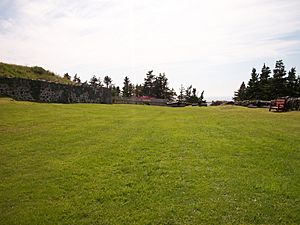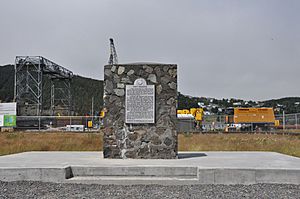Castle Hill, Newfoundland and Labrador facts for kids

Fort Royal
|
|
| Established | 1662 |
|---|---|
| Location | Placentia, Newfoundland and Labrador, Canada. |
| Type | Historic fortifications |
Castle Hill is a special place in Placentia, Newfoundland and Labrador, Canada. It holds the old remains of strong forts built by both the French and British. These forts were built high up on a hill to protect the town and the important fishing areas nearby. They also guarded the way to the French colony of Canada.
Contents
Early Forts and Battles
Protecting French Fishing Interests
To keep the bay safe, the French built their first fort, Fort Plaisance, in 1662. It was also known as Vieux Fort. This fort was important for protecting French fishing boats and settlements.
Attacks During King William's War
In 1690, during a time called King William's War, a group of 45 British raiders attacked Plaisance. They came by land, hurt the French governor, and took over the town. They destroyed the fort and held the people in the church for six weeks. The British left in April, taking many supplies with them.
The French quickly rebuilt their defenses. They replaced Fort Plaisance with Fort Saint-Louis in 1691, with 50 soldiers ready to defend it. In 1692, five English ships with 800 men tried to attack. They fired cannons at the town but eventually left. The French then attacked British settlements in St. John's in 1692 and 1694.
Building Fort Royal
In 1693, the French built an even stronger fort called Fort Royal on top of Castle Hill. This fort was very important for protecting the French colony from British warships. French forces often raided British towns during these wars. By the end of 1693, about 60 soldiers were stationed at Fort Royal.
A famous French leader, Pierre Le Moyne d'Iberville, even marched from Plaisance to attack English settlements. In 1697, a large British force took back St. John's, finding it empty and destroyed. The British then started building their own strong fort, Fort William, in St. John's, which was finished in 1700.
Queen Anne's War Conflicts
French Successes
When Governor Daniel d'Auger de Subercase arrived in 1702, things improved for the French. He made sure his soldiers were well-supplied and disciplined. He also got help from Mi'kmaq allies and privateer ships (ships hired by the government to attack enemies) to protect the sea.
In 1705, Subercase led an attack on English settlements. It was a big success! He captured the town of St. John's, but the soldiers inside Fort William held out. After a five-week siege (surrounding a place to attack it), Subercase returned to Placentia with many supplies and prisoners. Throughout 1706, French and Indigenous groups continued to attack and burn English communities.
British Blockade and French Counterattack
In 1708, the English tried to starve the French capital of Plaisance by blocking its port. But even with this blockade, a French leader named Joseph de Monbeton de Brouillan attacked English settlements. In January 1709, with 170 French, Canadian, and Indigenous men, he captured St. John's, took 800 prisoners, and destroyed the town's defenses.
By 1711, the French garrison (soldiers stationed there) at Plaisance had 250 men. However, in 1713, the French gave up their claim to Newfoundland. They moved to a new stronghold at Louisbourg on Cape Breton Island. British settlers and soldiers then took over the forts at Placentia, staying there until 1811.
Fort Frederick and New Fort
After the British took over, they briefly used Fort Louis. Then, under Governor Samuel Gledhill, they built a new defense called Fort Frederick (Newfoundland). This fort was an important military headquarters for Newfoundland from 1721 to 1746. There was a report during Father Rale's War that Mi'kmaq people attacked Plaisance and killed 200 English, but the governor did not believe this report.
In the 1740s, the British started building another fort, called New Fort, which was built over the old Fort Louis.
Castle Hill National Historic Site Today
Castle Hill National Historic Site was recognized as a National Historic Site in 1968. After many years of archaeological work, the ruins of the forts are now looked after by Parks Canada.
When you visit today, you can see:
- The remains of the walls of Gaillardin Redoubt, built in 1692.
- Parts of Fort Royal (1693–1703) and a separate defense from 1697.
- La Fontaine Battery from 1697 (its remains are still underground).
- The remains of a British blockhouse (a small, strong fort) from 1762.
- Horseshoe Battery (its remains are also still underground).
- Six old cannons that were added in the 1930s.
The visitor center at Castle Hill has exhibits that tell the story of the fort. You can learn about the lives of the fishing families and soldiers who lived there long ago.
Legacy and Recognition
On June 28, 1985, Canada Post released a stamp featuring 'Castle Hill, Nfld., circa 1762'. This stamp was part of a series called "Forts Across Canada." It helped people remember the important history of Castle Hill.
Soldiers at the Garrison
Over the years, many different groups of soldiers were stationed at Castle Hill:
- British Army
- French Army
- Independent Companies of Foot (1713–1718)
- Independent Company of Artillery (1713–1726)
- Ordnance Engineers (Royal Engineers) 1714–1870
- Phillip's Regiment of Foot (1718–1764)
- 1st. Battalion Royal Artillery (1726–1756)



